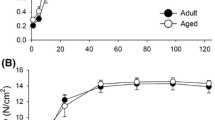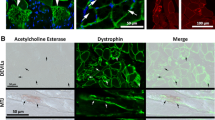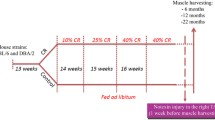Abstract
Tubular aggregates (TA’s) may comprise the major histopathologic finding in hyperkalemic and normokalemic periodic paralysis. They also constitute a conspicuous morphologic abnormality in a number of myopathies, and have been associated with non-specific muscle myalgias/cramps. Caloric restriction (CR) is an experimental manipulation that increases longevity and reduces lesions in mice as compared to animals fed ad libitum (AL). However, the impact of CR on the dynamics of muscle tissue has not been previously established. In this paper we week to characterize the relationship between tubular aggregates and age and determine whether they are modulated by caloric restriction.
We examined the effects of 40% caloric restriction (CR) on fiber damage formation in middle-aged (19 months of age) and older (27 months) mice. We also examined the effects of age and diet restriction on tubular aggregate formation in 12, 24, and 30 month old mice. Tissue blocks from the 19 and 27 month animals were also examined using electron microscopy for qualitative differences in tubular aggregates which may suggest a diet and age effect.
There appeared to be no fiber or Z-disc damage attributable to age as assessed by quantitative light microscopy (LM). Age and diet had significant effects on the percent of fibers occupied by tubular aggregates. Qualitative LM revealed that many TA’s may not have yet penetrated the sarcolemma in the young animals, and in particular, the young CR mice. The presence of round fibers was evident in the young CR mice whereas fibers were more angular in the AL mice.
Fiber splitting was also evident in the CR mice, perhaps associated with new fiber formation. Other observations especially prevalent in mice with higher degrees of tubular aggregates included centrally displaced nuclei, nuclear chains among the sarcolemma borders, interfasicular wedging, longitudinally split fibers and cellular infiltrates. Electron microscopic examination of these areas revealed non distinction of the TA ultrastructure as a result of aging and diet. Large clusters of TA’s were observed to be in close approximation with mitochondria and in some instances, mitochondria with internal vesicles were present. We conclude that diet restriction may reduce the accumulation of age-related tubular aggregates in skeletal muscle without altering their ultrastructure.
Similar content being viewed by others
References
Morgan-Hughes, J.A., Mair, W.G.P., and Lascelles, P.T.: A disorder of skeletal muscle associated with tubular aggregates. Brain, 93: 873–880, 1970.
Lazaro, R.P., Fenichel, G.M., Kilroy, A.W., et al.: Cramps, muscle pain, and tubular aggregates. Arch. Neurol., 37: 715–717, 1980.
Kunci, R.W., Pestronk, A., Lane, J., and Alexander, E.: The MRL +/+ mouse: a new model for tubular aggregates which are gender-and age-related. Acta. Neuropath. 78: 615–620, 1989.
Salviati, G., Pierobon-Bormioli, S., Betto, R., Damiani, E., Angelini, C., Ringel, S., Salvatori, S., and Margeth, A.: Tubular aggregates: sarcoplasmic reticulum origin, calcium storage ability, and functional complications. Muscle Nerve, 8: 299–306, 1985.
Schroder, J.M. and Becker, P.E.: Anomalien des T-Systems und des sarkoplasmatischen Reticulums bei der Myotonie, Paramyotonie und Adynamie. Virchows Arch [A]. 357: 319–244, 1972.
Schochet, S.: Diagnostic pathology of skeletal muscle and nerve. Norwalk, Appleton-Century-Crofts, 1990, p. 118.
Manfredi, T.G., Fielding, R.A., O’Reilly, K.P., Meredith, C.N., Lee, H.Y., and Evans, W.J.: Plasma creatine kinase activity and exercise-induced muscle damage in older men. Med. Sci. Sports Exer. 23: 1028–1034, 1991.
Manfredi, T.G., Evans, W.J., Lee, H.Y., Ding, W., and Verdon, S.: Quantification of ultrastructural damage in human skeletal muscle. Proc. Elect. Micros. Societ. Amer., edited by Bailey, G.W. and Hall, E.L.,, San Francisco Press, Inc., San Francisco, 1991, pp. 126–128.
Weindruch, R., Walford, R.L., Fligiel, S., and Guthrie, D.: The retardation of aging in mice by dietary restriction: longevity, cancer, immunity and lifetime energy intake. J. Nutri. 116: 641–654, 1986.
Bronson, R.t. and Lipman, R.D.: Reduction in rate of occurrence of age-related lesions in dietary restricted mice. Growth, Dev. and Aging. 55: 169–184, 1991.
Cameron, C.H., Allen, I.V., Patterson, V., and Avaria, M.A.: Dominantly inherited tubular aggragate myopathy. J. Pathol. 168: 397–403, 1992.
Rosenberg, N.L., Neville, H.E., and Ringel, S.P.: Tubular aggregates: their association with neuromuscular disease, including the syndrome of myalgias/cramps. Arch. Neurol. 42: 973–976, 1985.
Khanm, M.A.: Unique ultrastructural characteristics of pigeon antedor latissimus dorsi muscle. Cell. Mol. Biol. Res. 39: 65–71, 1993.
Chariot, PP., Benbrik, E., Schaeffer, A., and Gherardi, R.: Tubular aggregates and partial cytochrome c oxidase deficiency in skeletal muscle of patients with AIDS treated with zidovudine. Acta. Neuropathol. Beri. 85: 431–436, 1993.
Beyenberg, S. and Zierz, S.: Chronic progressive external ophthalmoplegia and myalgia associated with tubular aggregates. Acta. Neurol. Scand. 87: 397–402, 1993.
Manfredi, T.G., Ding, W., and Bronson, R.T.: Correlative light and electron microscopy of tubular aggregates in skeletal muscle. Proceed. Elect. Microscop. Soc. Amer., edited by Bailey, G.W., Bentley, J., and Small, J.A.: San Francisco Press, Inc., San Francisco, 1992, pp. 660–661.
Witt, W.M., Brand, D., Alwood, V.G., and Soave, O.A.: A nationally supported study on caloric restriction in rodents. Lab. Ani. 18: 37–43, 1989.
Manfredi, T.G., Ding, W., Lee, H.Y., Fielding, R.J., Fiatarone, M.A., Cannon, J.G., and Evans, W.J.: Quantification of skeletal muscle damage. Med. Sci. Sports Exer. 25:5 (Suppl.), S72, 1993.
Fielding, R.A., Manfredi, T.G., Ding, W., Fiatarone, M.A., Evans, W.J., and Cannon, J.G.: Acute phase response in exercise III. Neutrophil and IL-1b accumulation in skeletal muscle. Am. J. Physiol. 265 (Regulatory Integrative Comp. Physiol. 34): R166–R172, 1993.
Author information
Authors and Affiliations
About this article
Cite this article
Cosmas, A.C., Ding, W., Bronson, R.T. et al. Age and diet alter skeletal muscle tubular aggregates. AGE 18, 69–78 (1995). https://doi.org/10.1007/BF02432521
Issue Date:
DOI: https://doi.org/10.1007/BF02432521




